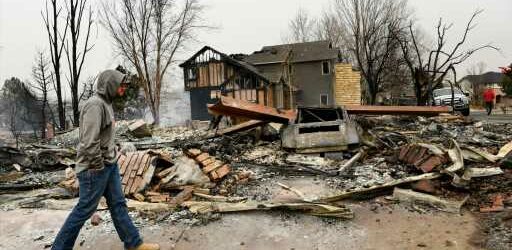An investigation that found a loose power line owned by Xcel Energy sparked one of two blazes that merged into Colorado’s most destructive wildfire is another chapter in the growing risk to utilities and their customers as the West dries out and heats up.
Xcel Energy, Colorado’s largest electric utility, has steadfastly disputed that any of its lines or equipment played a role in starting the Marshall fire. The fire that started Dec. 30, 2021, after a long dry spell and during a massive wind storm, killed two people, burned 1,000 homes and businesses and did more than $2 billion of property damage in Boulder County.
Xcel Energy said that it strongly disagrees with the results of the investigation released Thursday by Boulder County authorities.
“Xcel Energy did not have the opportunity to review and comment on the analyses relied on by the Sheriff’s Office and believes those analyses are flawed and their conclusions are incorrect,” company spokeswoman Michelle Aguayo said in a statement.
Boulder County District Attorney Michael Dougherty said he will not pursue charges against Xcel Energy or the owners of the property where investigators say the other fire started because there is no evidence to make a criminal case.
However, Xcel Energy is already looking at a civil lawsuit filed on behalf of property owners. The lawsuit filed by Boulder attorney Attorney James Avery and the Schack Law Group in San Diego claims the company’s equipment “substantially caused or contributed to the cause, origin and continuation” of the fire.
Natasha Serino, an attorney with the Schack Law Group, said Boulder County’s investigation confirmed what the law firms’ investigation of more than a year has shown. The firms, which filed the lawsuit in 2022, represent more than 100 clients.
“We wouldn’t have filed a lawsuit if we didn’t believe that Xcel was responsible, at least partially for the fire. But certainly it is always helpful to have a sheriff’s report or an official government report that is consistent with that,” Serino said.
The Schack Law Group has represented several people in lawsuits against Pacific Gas and Electric. The California utility is the most glaring example of the perils that utilities and their customers face in the era of climate change as a few downed power lines or malfunctioning equipment can ignite fires that end up torching communities and large-scale landscapes.
PG&E filed for bankruptcy in 2019 after its faulty equipment started several fires in California, including the 2018 Camp Fire that killed 84 people and destroyed the town of paradise.
Former PG&E executives reached a $117 million settlement agreement in 2021 in connection with the 2017 North Bay fires and the Camp Fire. Downed PG&E power lines touched off a dozen fires that raced through Northern California in October 2017 according to the California Department of Forestry and Fire Protection.
KK DuVivier, a professor at the University of Denver’s Sturm College of Law and an expert on national resources and energy law, said whether Xcel Energy is anywhere near as legally vulnerable as PG&E was will depend in part on Xcel’s history of equipment maintenance and the specific circumstances. She said it was known after some of the California fires that PG&E had lines that were more than 70 years old.
“They had notice there was a problem and they hadn’t addressed it,” DuVivier said.
A plan filed in March by PG&E shows it plans to spend about $18 billion to protect its electric grid against the threat of wildfires through 2025. The plan includes installing stronger poles, covered power lines, tree trimming and 10,000 miles of underground lines.
Robert Kenney, president of Xcel Energy-Colorado, worked for nearly seven years at PG&E, where he led the utility’s regulatory strategy and execution. The utility said in a 2022 report that it has spent more than $375 million on wildfire mitigation.
A report of the investigation into the Marshall fire said Xcel Energy’s equipment at the site where the second fire started was in good condition, Dougherty said. Investigators and fire experts didn’t find any evidence of criminal recklessness or negligence in the system design, maintenance or wiring, he added.
“The poles, conductors and insulators in that specific area were in good condition. They looked at it very closely,” Dougherty said.
But Dougherty said based on the 17-month investigation, “it’s more likely than not” that the winds, some of which exceeded 100 mph, caused the line to disconnect and spew sparks when it hit other lines.
Despite initial reports of downed power lines in the area, Xcel Energy said it didn’t find any where the fire started. Xcel referred to the line pinpointed by the investigation as a “floating” line, one that had become unmoored but wasn’t touching the ground.
Dougherty said the distinction Xcel Energy made between a downed line and one that was disconnected was consistent with the way the company regularly describes a so-called floater.
When investigators went to the site, the line had been reattached to a crossarm, according to the report. Xcel had issued a do-not-repair order for the area to preserve the scene while the cause was investigated, so authorities looked into why the line had been fixed.
Investigators obtained search warrants to interview employees, who talked voluntarily. They reviewed Xcel Energy documents.
“There’s no evidence at all that they repaired the line in an effort to impede the investigation or hide something from criminal or civil proceedings,” said Dougherty, noting that Xcel had been urged to restore power quickly to the area after it started snowing and turned cold.
Source: Read Full Article



